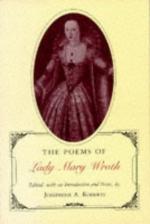|
This section contains 6,537 words (approx. 22 pages at 300 words per page) |

|
SOURCE: "Feminine Identity in Lady Mary Wroth's Romance Urania," in English Literary Renaissance, Vol. 14, No. 3, Autumn, 1984, pp. 328-46.
In this excerpt, Swift discusses Wroth's portrayal of the search for female identity through the characters Pamphilia and Urania, and draws parallels to Wroth's own struggle for acceptance and recognition in seventeenth-century society.
In 1621 Lady Mary Wroth published The Countesse of Mountgomeries Urania, a beautiful folio divided into four lengthy books, approximately 600 pages of prose and poetry that concludes with the sonnet sequence Pamphilia to Amphilanthus. An unpublished 145-page manuscript, evidently in Wroth's own hand and now at the Newberry Library, continues the story into a second generation but remains incomplete. Generally ignored today, Lady Wroth was recognized by many of her contemporaries. But while patronage may explain the attention of Jonson, Wither, and Chapman, still many of her 120 songs and sonnets, as well as much of Urania, can justify...
|
This section contains 6,537 words (approx. 22 pages at 300 words per page) |

|


